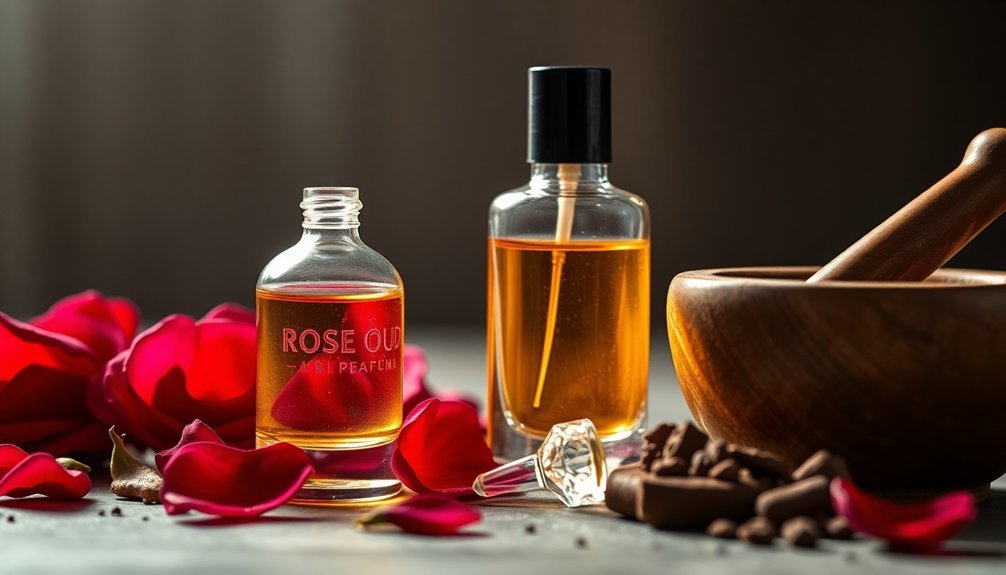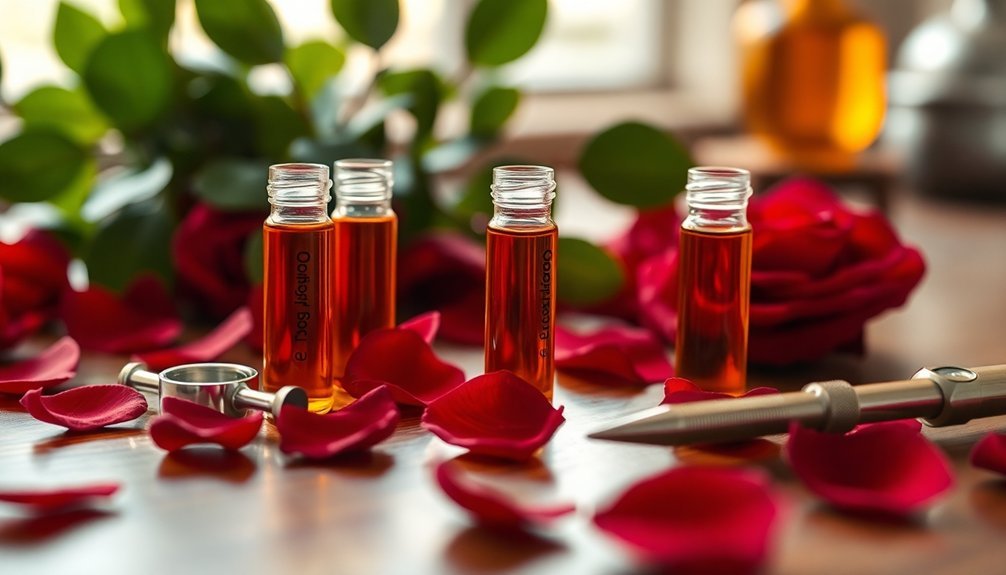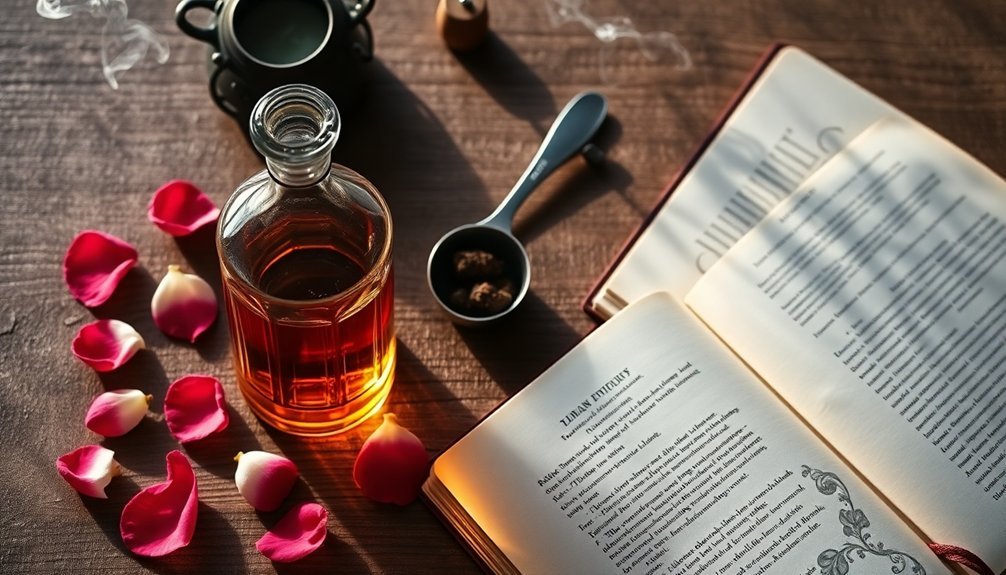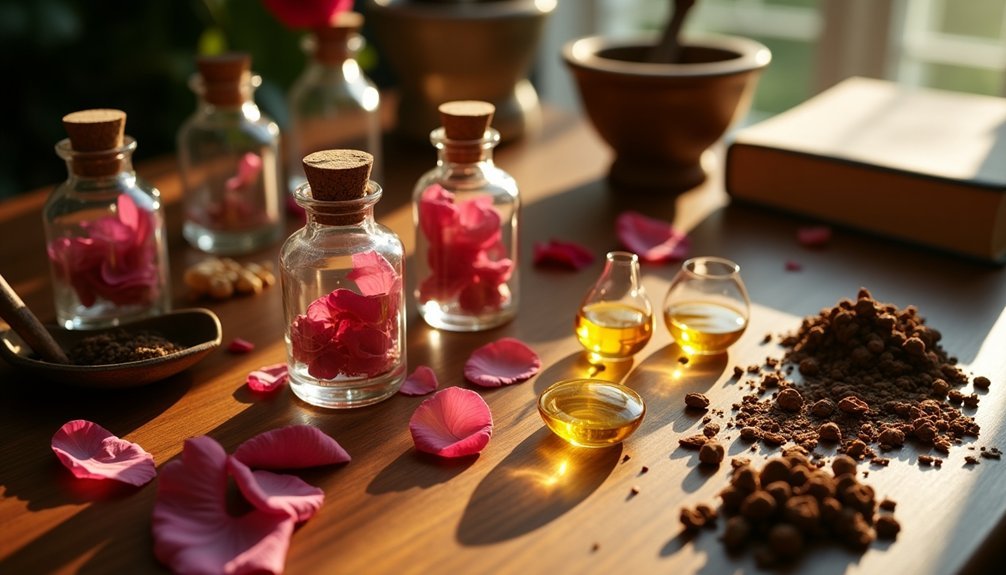Create your own luxurious Rose-Oud Arabian perfume by combining quality oud accord (10-15%) with Damask rose absolute in a 4:1 ratio. Start with base notes like sandalwood and amber, add middle notes of rose and geranium, then finish with bergamot and black pepper top notes. Let your blend mature for 4-8 weeks in a dark glass bottle at room temperature. Master perfumers know the secrets lie in precise measurements and patient maturation techniques.
The Magic of Rose-Oud in Arabian Perfumery

While many fragrances have come and gone throughout history, the mystical combination of rose and oud has remained an enduring cornerstone of Arabian perfumery.
You'll find this luxurious pairing deeply rooted in ancient traditions, where it's been cherished for thousands of years in sacred rituals and meditation practices. The precious essence comes from dark resinous heartwood that forms when the Aquilaria tree becomes infected with mold.
The magic lies in how these two essences complement each other perfectly. Oud's rich, exotic base provides an unmatched depth and longevity that's earned it the nickname "liquid gold," while the delicate Centifolia rose adds graceful, floral notes that soften the intensity.
In Arabian culture, you're not just wearing a fragrance – you're embracing a symbol of hospitality, warmth, and refinement.
This timeless combination creates a complex aroma that modern perfumers still can't replicate synthetically.
Essential Ingredients for Your Rose-Oud Creation
To create an authentic rose-oud perfume, you'll need a carefully curated selection of ingredients that work in harmony.
Start with top notes of bergamot and clove, balanced by rosewater and praline for an initial sweet-spicy impression. Black pepper adds a sharp accent that shifts smoothly into the heart. Middle Eastern perfumers often select agarwood in colognes for their distinctive creations.
Your middle notes should center around Damask rose, supported by geranium and ylang ylang for a rich floral core. Patchouli and carnation accord provide depth and complexity.
For the foundation, combine oud accord with sandalwood and cedarwood, while amber and musk add sensual warmth.
Don't forget the supporting ingredients – they're essential for a professional result. Cashmeran helps blend your florals with woods, while Iso E Super enhances longevity.
Vanillin and labdanum round out the composition with sweet, resinous undertones.
Understanding the Art of Oud Selection

When creating your own Rose-Oud perfume, you'll need to choose between natural Oud, which offers authentic richness but comes at a premium price, and synthetic Oud, which provides consistency and affordability.
The quality grades of Oud range from the highest "super grade" sourced from century-old trees to more affordable options from younger trees, each impacting the final scent profile of your perfume. Steam distillation methods are essential for extracting the purest form of Oud oil from the heartwood.
You'll discover distinct characteristics in Oud from different regions, such as the sweet, woody notes of Indian Oud or the intense, smoky qualities of Cambodian Oud, allowing you to select the perfect variety for your blend.
Natural Vs Synthetic Oud
Choosing between natural and synthetic oud can make or break your Arabian perfume creation.
While natural oud offers a complex profile with smoky, animalic, and woody notes, synthetic versions typically deliver a linear, one-dimensional scent that's mainly cedarwood-like and leathery.
You'll find natural oud considerably more expensive, but it's worth considering for its rich, multifaceted aroma containing up to 150 different aromatic compounds.
If you're on a budget, synthetic oud costs about $1 per gram, compared to natural artisanal oud at up to $3,500 per gram.
However, don't be tempted by plantation-grown alternatives – they're harvested prematurely and lack depth.
For authentic Arabian perfumes, you'll want to invest in artisanal oud, which benefits from traditional distillation methods and proper aging processes.
Quality Grades Explained
Since mastering oud selection requires understanding its quality grades, you'll need to familiarize yourself with the established grading system. For DIY perfumery, focus on recognizing the three main commercial grades that you're most likely to encounter:
| Grade Level | Characteristics | Best For |
|---|---|---|
| Triple Super | Complex scent, high resin | Special fragrances |
| Super | Good balance, medium potency | Daily perfumes |
| Standard | Lighter aroma, affordable | Learning blends |
When selecting oud for your rose perfume, look for physical indicators like oil clarity and density. You'll want to assess the cold scent profile, ensuring it complements rose notes. While Kyara grade exists, it's typically beyond DIY perfumery's scope. Consider starting with Indonesian or Indian Super grade oud, as they offer good quality at reasonable prices.
Regional Oud Characteristics
The art of selecting oud for your rose perfume depends heavily on understanding its distinct regional characteristics.
You'll find that Southeast Asian ouds like Cambodian varieties offer sweet, fruity profiles that pair beautifully with rose, making them ideal for beginners. Vietnamese oud brings rich, peppery notes, while Indonesian oud varies from green and smoky to wild and earthy.
For more complexity, consider South Asian varieties like Hindi oud, which opens with barnyard notes before evolving into leather and incense.
If you're seeking lighter elements, Borneo oud provides ethereal, floral qualities with a clean woody finish.
Each region's oud will dramatically affect your final composition – Malaysian varieties add earthiness and fruit, while Chinese oud contributes citrus brightness and deep musk notes.
Choose based on the specific character you want your rose perfume to express.
Mastering Rose Accords for Authentic Blends

To create an authentic rose accord, you'll need to understand how natural rose extracts are obtained through steam distillation and solvent extraction methods.
When balancing your rose accord, start with phenylethyl alcohol as your foundation, then carefully layer in geranial and citronellal to match the proportions found in natural rose oil.
You can enhance the authenticity by incorporating damascones and ionones, which provide the characteristic deep floral notes present in genuine rose extracts.
Essential Rose Extraction Methods
Understanding rose extraction methods proves essential for creating authentic Arabian perfumes with true rose accords.
When working with roses, you'll want to avoid steam distillation, as it can damage the delicate petals and compromise the fragrance.
Instead, focus on solvent extraction using hexane or ethanol, which effectively preserves the rose's aromatic compounds.
For a traditional approach, you might explore enfleurage, where you'll layer fresh petals on odorless fat to capture their essence. While labor-intensive, this method yields high-quality results.
Modern perfumers often prefer supercritical fluid extraction with CO2, operating at specific temperatures and pressures.
If you're starting small, try maceration by soaking semi-dried rose petals in alcohol for several weeks, remembering to agitate periodically and filter the final product.
Balancing Rose Floral Notes
Mastering rose accords demands careful attention to four essential combinations: fruity, spicy, woody, and chypre blends. When creating your rose-oud Arabian perfume, you'll want to explore these variations to achieve depth and authenticity.
Start by experimenting with the rose-fruity accord, combining fresh citrus and sweet red fruits like lychee to enhance the floral vibrancy.
For a Middle Eastern touch, incorporate warm spices such as saffron, cinnamon, or cardamom, being careful not to overpower the delicate rose notes.
You can add sophistication with woody elements like cedar or sandalwood, which provide longevity and sensuality.
For a complex profile, consider a chypre approach by blending citrus top notes with oakmoss and patchouli base notes.
Remember to balance synthetic and natural rose elements for consistency and quality.
Natural Rose Accord Components
Building upon the foundations of rose accord variations, the specific aroma chemicals that create an authentic rose scent require careful attention.
You'll want to start with geraniol, which provides that characteristic morning dew smell, and citronellol, offering a lemony-oily touch. These two components make up the largest percentage of natural rose oil.
To achieve a realistic rose accord, you'll need phenylethyl alcohol (PEA) for its petal-like diffusion.
Add it in higher concentrations than citronellol and geraniol to match the profile of rose absolutes. For depth, incorporate beta-damascone to bring out jammy, fruity aspects.
Don't forget rose oxide – it's essential for authenticity. If you're seeking alternatives, consider rhodinol 70 or phenoxanol instead of standard citronellol to avoid any metallic undertones.
Step-by-Step Blending Instructions

To create a luxurious rose-oud Arabian perfume, you'll need to follow a precise blending sequence that begins with gathering your essential oils, fixatives, and equipment. Start by measuring your ingredients according to the 2:1:1 base-heart-head ratio, using pipettes for accuracy.
| Step | Action |
|---|---|
| 1 | Add base notes (galaxolide, ethylene brassylate) |
| 2 | Blend heart notes (rose jco, black argow wood) |
| 3 | Mix top notes (bergamot, cardamom) |
| 4 | Test and adjust proportions |
Layer your ingredients systematically, starting with the base notes, then adding heart notes, and finishing with top notes. After thorough mixing, let your blend mature in a dark place for at least a week. Test the fragrance on your skin or a testing strip, making adjustments as needed. Once satisfied, transfer to an atomizer bottle for final use.
Balancing Notes for Perfect Harmony
You'll want to start with a 3:2:1 ratio of top to middle to base notes for your Rose-Oud blend, keeping the oud as a base note at 10-15% of the total composition.
When layering rose and oud, add the oud first to establish the foundation, then build up the middle notes with rose absolute before finishing with bright top notes like bergamot or cardamom.
The key to a balanced accord lies in letting the oud's deep, woody character support rather than overwhelm the floral heart, while maintaining clear shifts between each layer of the fragrance.
Top-Middle-Base Ratio Guide
When crafting your Arabian rose-oud perfume, understanding the delicate balance between top, middle, and base notes becomes vital for achieving a harmonious blend.
While there's no strict one-size-fits-all formula, you'll want to follow these general ratios for a well-structured fragrance:
- Start with middle notes making up 50-75% of your blend, as they'll form the heart of your rose-oud composition.
- Add top notes at 20-40%, which will create that essential first impression.
- Finish with base notes at 5-10%, allowing the oud and other deep elements to anchor the fragrance.
- Consider alternative ratios like 3:2:1 or 4:2:1 if you're seeking a different character.
Remember to add ingredients drop by drop, carefully recording each addition while allowing your blend to mature for several days before making final adjustments.
Oud-Rose Layering Secrets
Mastering the delicate interplay between oud and rose requires a thoughtful approach to layering these precious ingredients. You'll want to start with equal parts of each oil on perfume strips, allowing them to settle before making adjustments. Remember, oud's earthy depth must harmonize with rose's delicate floral notes without either dominating the blend.
| Element | Emotional Impact |
|---|---|
| Oud | Mysterious, grounding |
| Rose | Romantic, uplifting |
| Spices | Warm, inviting |
| Woods | Deep, comforting |
| Time | Transformative, revealing |
To achieve perfect balance, consider adding complementary notes like cardamom or saffron gradually. Let your blend mature for a week or two, testing small amounts on your skin. You can fine-tune the proportions by introducing sandalwood to smooth out any sharp edges, creating a luxurious Arabian-inspired fragrance that's uniquely yours.
Essential Accord Proportions
Three essential proportions form the foundation of a successful rose-oud perfume: the delicate balance between top, middle, and base notes; the ratio of rose to oud; and the careful integration of complementary accords.
To achieve the perfect harmony in your blend, follow these critical proportions:
- Start with a 3:2:1 ratio for your top, middle, and base notes – this creates a well-rounded fragrance that evolves beautifully on the skin.
- Maintain a 1:4 ratio of rose to oud (20% rose, 80% oud) as your starting point, adjusting gradually based on the intensity of your specific ingredients.
- Add complementary accords like sandalwood or amber at 10-15% of the total blend to enhance depth.
- Incorporate spice notes such as saffron at 5% to add complexity without overwhelming the main accords.
Maturation and Storage Guidelines
To create a truly exceptional Rose-Oud Arabian perfume, you'll need to master both the maturation process and proper storage techniques. Store your blend in a dark glass bottle at room temperature for 4-8 weeks, allowing the rose and oud notes to harmonize fully. During this time, avoid disturbing the mixture except for weekly testing.
| Phase | Duration | Key Actions |
|---|---|---|
| Initial Rest | Week 1-2 | Store undisturbed in dark place |
| First Check | Week 3 | Test on skin, note changes |
| Adjustment | Week 4-6 | Fine-tune if needed |
| Final Rest | Week 7-8 | Allow final harmonization |
Monitor your perfume's development through skin testing, documenting any changes in the scent profile. You'll notice the harsh alcohol notes soften while the rose-oud accord becomes more sophisticated and balanced. Keep your final product in an airtight container away from light and heat.
Common Blending Mistakes to Avoid

While creating your Rose-Oud Arabian perfume, you'll need to navigate several common pitfalls that can affect your final blend. The most essential aspects of successful blending involve precise measurements, proper maturation, and careful handling of your ingredients.
To guarantee your Rose-Oud perfume achieves its full potential, avoid these critical mistakes:
- Don't rush the maturation process – allow at least 48 hours for your blend to harmonize and develop its complex character.
- Use standardized droppers or pipettes for consistent measurements, especially when working with potent oils like oud.
- Store your blend in dark glass bottles away from sunlight and heat to preserve its integrity.
- Test small batches before scaling up, and always smell each addition before moving forward with your next ingredient.
Customizing Your Rose-Oud Signature
Creating your signature Rose-Oud fragrance allows you to express your unique personality through carefully selected combinations of scents.
Start by choosing your preferred rose accord, like Rose JCO, and pair it with black agarwood to establish your base. You'll want to experiment with supporting notes like sandalwood and magnolia to add depth and character.
For a personalized touch, try layering different concentrations on various pulse points – perhaps a stronger oud presence on your neck and a lighter floral blend on your wrists.
Don't forget to adjust your creation seasonally; opt for airier florals in summer and richer woody notes in winter.
Consider adding subtle sweet elements through gourmand notes, but use them sparingly.
Test each combination thoroughly to guarantee the dry-down matches your desired scent profile.
Expert Tips for Long-Lasting Fragrance

Since mastering the art of long-lasting fragrance requires proper preparation, start by moisturizing your skin thoroughly before applying your Rose-Oud perfume. Use an unscented lotion to create the perfect canvas for your signature scent, focusing on pulse points where you'll apply the fragrance.
For ideal results, follow these essential steps:
- Apply 4-6 sprays to warm pulse points – wrists, neck, behind ears, and inner elbows.
- Create a scent cloud by spraying in front of you and walking through it.
- Let the fragrance dry completely before dressing to preserve its integrity.
- Store your Rose-Oud perfume in a cool, dark place to maintain its quality.
Don't rub your wrists together after application, as this can break down the scent molecules. Instead, let your body's natural warmth diffuse the fragrance throughout the day.
Frequently Asked Questions
Can I Substitute Synthetic Oud if Authentic Oud Is Unavailable?
Yes, you can use synthetic oud as a substitute. While it won't match authentic oud's complexity, it's more affordable, sustainable, and readily available. It'll still give you the characteristic woody, leathery aroma you're seeking.
How Much Should I Expect to Spend on Ingredients?
You'll typically spend between $75-150 for basic perfume ingredients. If you're using authentic oud oil, expect to pay considerably more. You can reduce costs by using synthetic alternatives and smaller quantities.
Is It Safe to Apply Homemade Perfume Directly to Skin?
No, you shouldn't apply homemade perfume directly to skin. Always dilute essential oils with carrier oils (80% carrier, 20% fragrance), and do a patch test first to check for allergic reactions.
Where Can I Source Authentic Middle Eastern Oud Oil?
You'll find authentic oud oil through reputable suppliers like Ensar Oud or verified UAE dealers. Look for detailed sourcing information, quality guarantees, and be prepared to invest considerably, as genuine oud is quite expensive.
Will Temperature Changes Affect My Perfume's Scent During International Travel?
Yes, temperature changes during travel can temporarily affect your perfume's scent, but it's usually not permanent. You'll notice variations in projection and longevity, but your fragrance will stabilize once it returns to normal conditions.
In Summary
You're now equipped to create your own authentic rose-oud perfume blend. Remember to start with high-quality ingredients, follow the proper ratios, and allow time for maturation. Don't rush the process – perfumery is an art that rewards patience. As you experiment with different combinations, you'll develop your signature scent. Trust your nose, keep notes of your successes, and enjoy your journey into Arabian perfumery.
References
- https://www.youtube.com/watch?v=Jsw1enSKPgw
- https://amiroud.com/blog/how-to-choose-the-perfect-oud-perfume-for-any-occasion
- https://basenotes.com/community/threads/rose-oudy-formula-with-percentages-for-beginners-from-matt.459014/
- https://www.youtube.com/watch?v=C9pQ_pjLDrY
- https://www.youtube.com/watch?v=jabA_7uBId0
- https://www.pairfum.com/oud-fragrance-the-essence-of-arabic-perfumes/
- https://irfe.com/arabian-oud-perfume/
- https://www.youtube.com/watch?v=x6Og_3CASMI
- https://sa.mubkhar.com/blogs/scents-guide/top-arabian-scents-meanings-and-history
- https://www.scentiment.com/products/rose-oud-1





Leave a Reply